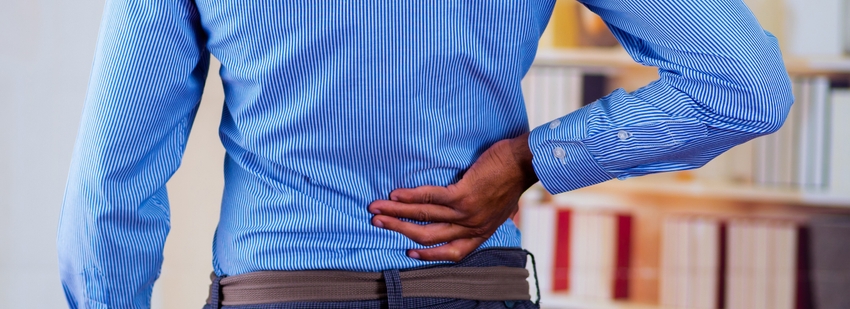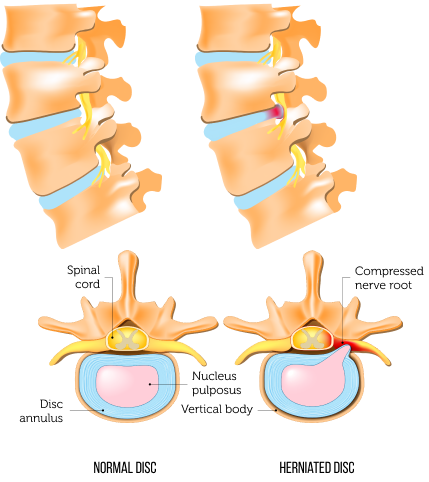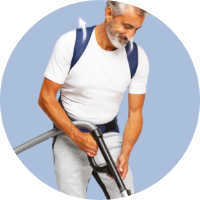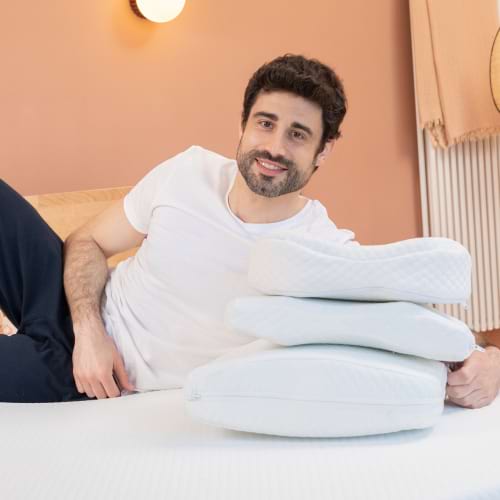
Slipped Disc
A slipped disc is when the soft cushion of tissue between the bones in your spine pushes out. As it protrudes it can cause a compression of one of your spinal nerves which can lead to numbness and pain.
From symptoms to possible treatments, here is a summary of all you need to know about slipped discs (also known as prolapsed or herniated discs).
- 1. What is a slipped disc?
- 2. What are the causes of a slipped disc?
- 3. Treatment for a slipped disc
- 4. PERCKO, a long-term complementary solution

1. What is a slipped disc?
Your spine is made up of a series of bones (vertebrae), separated by discs (intetervetrebal discs), all stacked up on top of each other. These discs act as soft cushions protecting your bones from daily activities such as walking, running, bending and twisting.
Discs are relatively flat and round to match the shape of your bones. They are about six millimetres thick and have two parts:
- A tough outer ring, hard yet flexible
- A gelatinous centre
A slipped disc occurs after damage to the tough outer ring of the disc. Many factors can cause damage including age, certain motions and incorrect lifting techniques. Depending on the person, deterioration can happen slower or faster. Over time, the gelatinous centre is pushed out through the damaged outer ring. As it protrudes it can lead to the compression of one of your spinal nerves which can cause numbness and pain.
Whilst slipped discs can happen at any level of the spine they are most common in the lower back, around the fourth and fifth vertebrae. There are two reasons for this, both due to the lower back’s central anatomical position. Firstly the lower back must absorb larger shocks due to the additional weight above it. Secondly the lower back must deal with any stresses originating from the bottom half of your body (e.g. from walking or running).
2. What are the causes of a slipped disc?
The most common cause of a slipped disc is natural wear and tear due to age. Men between the ages of 30 and 50 are particularly at risk. The main causes of slipped discs are:
- Ageing
- Exercising too hard
- Lifting heavy objects the wrong way
- Vibration from driving or operating machinery
- Being inactive or overweight
The causes of slipped discs are particularly correlated to the positioning of the back. Slouching leads to unnecessary pressure on the discs of your back, causing premature and accelerated wear and tear. Regular movement and changes of position are therefore of the utmost importance in preventing slipped discs.
3. Treatment for a slipped disc
How you can ease the pain from a slipped disc yourself
Keep active
If the pain is very bad, you may need to rest at first. But start gentle exercise as soon as you can – it'll help you get better faster.
The type of exercise is not important, just gradually increase your activity level.
Take painkillers
Alternate painkillers such as ibuprofen and paracetamol. Paracetamol on its own is not recommended for back pain.
Take them regularly (up to the recommended daily amount) rather than just when the pain is particularly bad. This will help you to keep moving.
A pharmacist can help with a slipped disc
Non-steroidal anti-inflammatory drugs (NSAIDs) like ibuprofen are not suitable for everyone. Speak to a pharmacist if you're not sure.
Stronger painkillers containing codeine may help for pain that's just started.
But these types of painkillers can cause addiction and should only be used for a few days.
Treatment for a slipped disc from a GP
A GP might prescribe a stronger painkiller, a steroid injection or a muscle relaxant to use in the short term.
If your symptoms do not get better, a GP might recommend further tests, like an MRI scan.
They might also refer you to a physiotherapist. Physiotherapy from the NHS might not be available everywhere and waiting times can be long. You can also get it privately.
Surgery for a slipped disc
Surgery is not usually needed, but a GP might refer to you a specialist to discuss surgery if your symptoms:
- have not improved using other treatments
- include worsening muscle weakness, or numbness
Alternative treatments for a slipped disc
There's some evidence that manual therapies, like osteopathy, can help ease lower back pain.
You'll usually have to pay for this treatment privately.
Information from the NHS website
4. Percko, a long-term complementary solution
A slipped disc is usually diagnosed by a GP when a patient complains about a significant pain in the buttock or thigh. As listed above, the usual course of treatment will be the prescription of painkillers and a referral for further tests and/or to a physiotherapist in the case of persistent pain. Usually a slipped disc will heal on its own in six weeks (rarely before).
The goal of any treatment will be to relax the muscles around the slipped disc thus reducing pressure around the affected area. Further to this, sessions may be prescribed to strengthen your core and back muscles to avoid future injury.
Whatever the treatment plan, as a general rule you will be advised to avoid prolonged periods of inactivity as well as regular exercise to encourage mobility and to maintain a strong core and back muscles. PERCKO developed Lyne technology to address this cardinal rule of good back health.
Patented by PERCKO, Lyne technology is an elasticated system of tenors which apply pressure to the shoulders and the lower back. The elasticated system of tensors provides a gentle reminder, through a feeling of resistance, to the user to adopt a healthier posture whenever they begin to slouch. It is firmly based on the understanding that a user must retain a certain level of autonomy in the process of maintaining a healthy back. This sets PERCKO products apart from lumbar belts, which leave no autonomy to the wearer and can actually cause the muscles to atrophy instead of strengthening them.
Lyne technology, built into all PERCKO T-shirts and vests, is the result of continuous research and development carried out since 2014 alongside a team of experts in biomechanics, physiotherapists and osteopaths.
PERCKO T-shirts and vests help prevent slipped discs by:
- Encouraging the user to avoid long periods in static/slouched positions. By maintaining mobility in the back, pressure is more evenly distributed throughout the spine and the discs themselves.
- Keeping the user mobile, engaging the core and strengthening the back muscles. This helps the spine maintain a better curvature which improves the ability of the discs to absorb shocks from daily activities.
All products in the Lyne range are certified medical devices. They were developed in France and are currently recommended by over 1,700 health professionals, including physiotherapists, osteopaths and work ergonomists.
To choose the right Lyne product for you, click here.
Information from the NHS website is licensed under the Open Government Licence v3.0.



